 |
James L. Holly, M.D. |
|
 |
|
|
|
|
|
|
|
|
National surveys indicate that the majority of physicians under code their services because of fear of being audited by the government. The reality is that very precise standards have been established to guide healthcare providers in determining the value of their services. These standards are complex and difficult to always keep in mind, therefore, most providers simply reduce their coding to accommodate for this problem.
Unfortunately, as reimbursements continue to be decreased, this compounds the financial pressure on private healthcare providers to sustain their practices and to continue to provide care to patients who are insured by government programs which are subject to the political caprice of election promises.
SETMA's E&M Coding Recommendations function is our answer to this dilemma, i.e., the desire to remain in compliance with government regulations while at the same time being able to remain in practice.
The calculations which are built into the E&M Coding Recommendations take into account the following:
- The evaluation and updating of the status of chronic conditions. See the Tutorial on Chronic Conditions.
- The use of any or all of SETMA's disease management tools.
- Your assessment of the complexity of medical decision making.
Remember, this coding recommendation is a recommendation, special circumstances may warrant a different code, either higher or lower, but in general this will give you a good estimation as to whether the code you chose would survive a Medicare audit.
The E&M Coding Recommendation is launched from the Master GP Evaluation and
Management (E&M) Charge Posting Template.
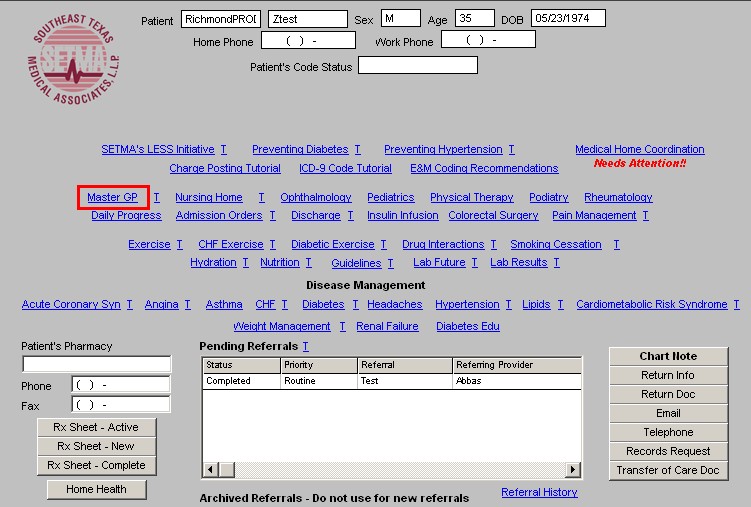

- The E&M Chart Posting Template is launched by clicking the Eval & Mgmt link at the top right hand of the Plan Template.
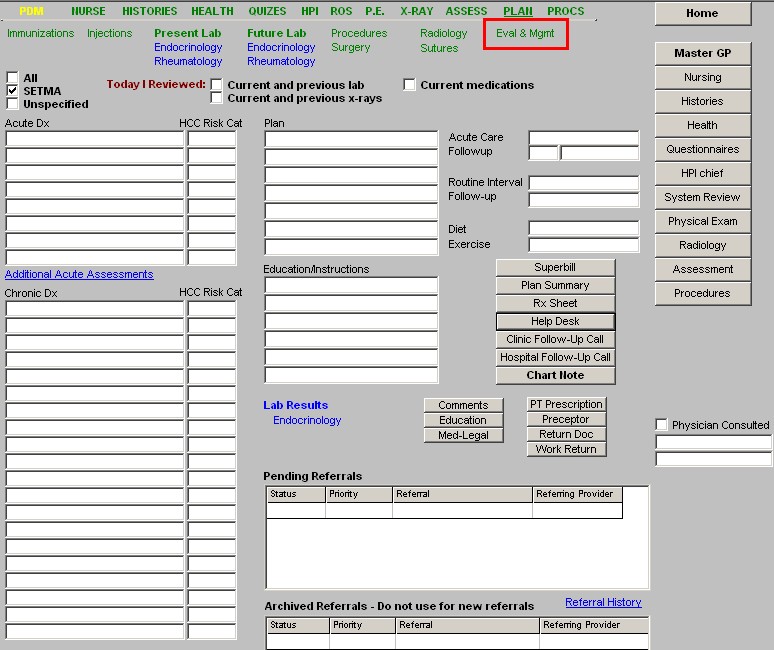
- The E&M Code Recommendation function is launched by depressing the button entitled Recommendations which is found above the Submit Button at the top right of the Evaluation and Management Template.
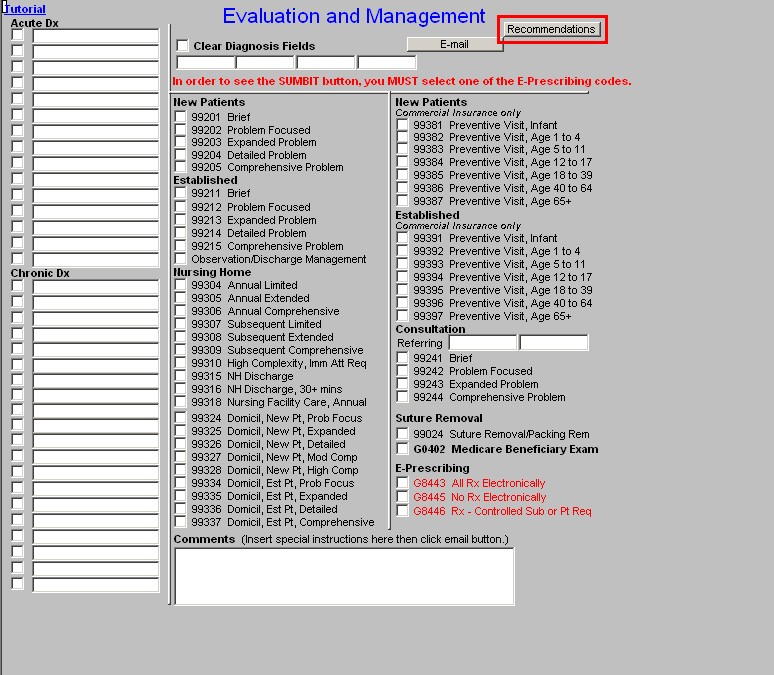

Content of the E&M Coding Recommendations Template
In red, an instruction is give, "Please respond to the highlighted questions below before clicking
'Calculate'."
The following five data points are automatically counted and the results displayed.
Chief Complaint -- You have listed _________ chief complaints for this visit.
History of Present Illness -- You have sufficiently documented the HPI for ________ of the chief complaints.
Review of Systems -- You have accessed the ROS for ________ systems
History -- You have accessed ________ elements of the patient’s history
Physical Exam -- You have accessed ________physical exam for systems.
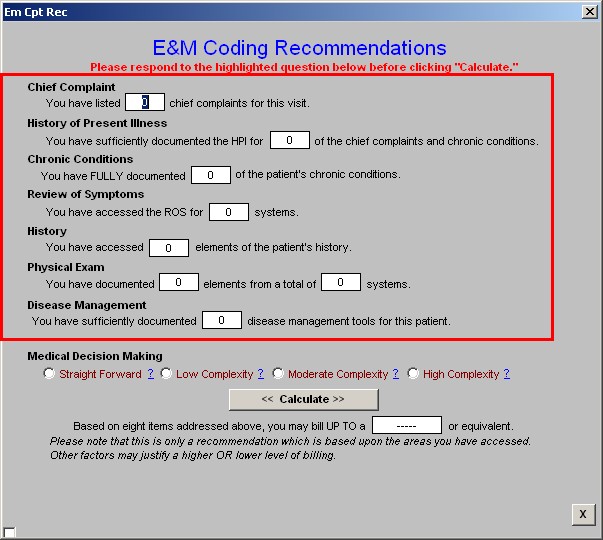
At this point there are two questions which you must answer in order to get an E&M Recommendation for this visit:
- Did you document at LEAST 2 elements from EACH of the physical exam areas that you accessed?
- Medical Decision Making:
| Level of Risk |
Presenting Problem(s) |
Diagnostic Procedure(s) ordered |
Management option(s) selected |
| Minimal |
- One self-limited or minor problem (e.g. cold, insect bite, tinea coporis)
|
- Laboratory tests requiring venipuncture
- Chest X-Ray
- ECG/EGG
- Urinalysis
- Ultrasound(e.g.echocardiography)
- KOH prep
|
- Rest
- Gargles
- Elastic bandages
- Superficial dressings
|
| Low |
- Two or more self-limited or minor problems
- One stable chronic illness (e.g. well-controlled hypertension, non-insulin dependent diabetes, cataract, BPH
- Acute uncomplicated illness or injury (e.g. cystitis, allergic rhinitis, simple sprain
|
- Physiologic tests not under stress(e.g. pulmonary function tests)
- Non-cardiovascular imaging studies with contrast (e.g. barium enema)
- Superficial needle biopsies
- Clinical laboratory tests requiring arterial puncture.
- Skin biopsies
|
- Over-the-counter drugs
- Minor surgery with no identified risk factors.
- Physical therapy
- Occupational therapy
- I.V. fluids w/o additives
|
| Moderate |
- One or more chronic illness or injury with mild exacerbation, progression, or side-effects of treatment
- Two or more stable chronic illnesses.
- Undiagnosed new problem with uncertain prognosis(e.g., head injury with brief loss of consciousness)
|
- Physiologic tests under stress test.
- Non-cardiovascular imaging studies with no identified risk factors
- Deep needle or incisional biopsy
- Cardiovascular imaging studies with contrast and no identified risk factors (e.g., arteriogram, cardiac catheterization)
- Obtain fluid from body cavity (e.g. lumbar puncture, thoracentesis,culdocentesis)
|
- Minor surgery with identified risk factors
- Elective major surgery (open, percutaneous, or endoscopic) with no identified risk factors.
- Prescription drug management
- Therapeutic nuclear medicine
- I.V. fluids with additives
- Closed treatment of fracture or dislocation without manipulation)
|
| High |
- One or ore chronic illnesses with severe exacerbation, progression or side effects of treatment.
- Acute or chronic illnesses or injuries that may pose a threat to life or bodily function (e.g., multiple trauma, acute MI, pulmonary embolus, severe respiratory distress, progressive severe rheumatoid arthritis, psychiatric illness with potential threat to self or others, peritonitis, acute renal failure)
- An abrupt change in neurologic status (e.g., seizures, TIA, weakness, or sensory loss)
|
- Cardiovascular imaging studies with contrast with identified risk factors
- Cardiac electrophysiological tests
- Diagnostic endoscopies with identified risk factors
- Discography
|
- Elective major surgery (open, percutaneous, or endoscopic) with identified risk factors.
- Emergency major surgery (open, percutaneous, or endoscopic)
- Parenteral controlled substances.
- Drug therapy requiring intensive monitoring for toxicity
- Decision not to resuscitate or to deescalate care because of poor prognosis.
|
|
An explanation of each of the levels of medical decision making is given by clicking on the name.
Once these two question are answered, depress the Calculate button
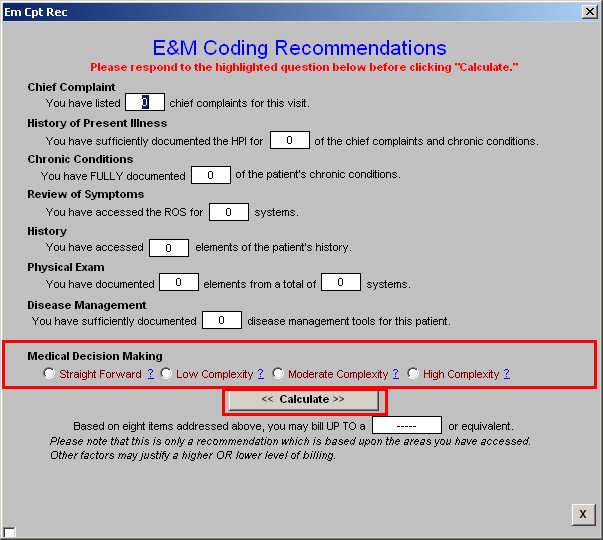
The box, surrounded by the following text, "Based on six items addressed above, you may bill UP TO a ________ or equivalent." will then display the E&M Code which is recommended that you use.
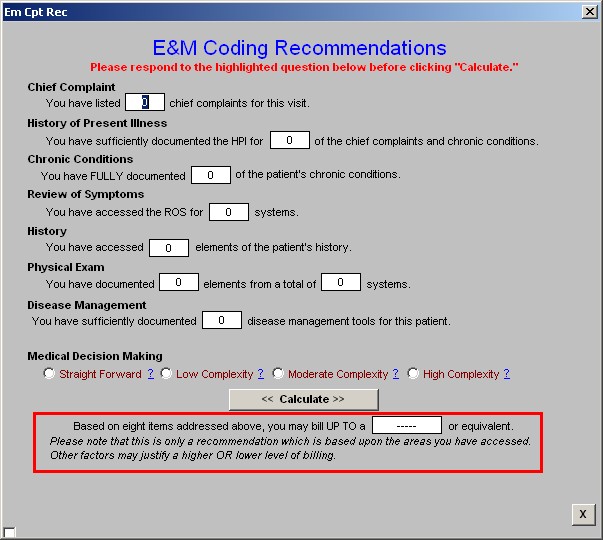
The template is concluded with the following comment which is very important, "Please note that this is only a recommendation which is based upon the areas you have accessed. Other factors may justify a higher OR lower level of billing."
At this point, you are ready to return to the Evaluation and Management Charge Posting Template and complete the charging of the E&M for this visit. At the top left of this template, there is a link entitled Tutorial, which will take you to an explanation of how to appropriately complete the charge posting templates.
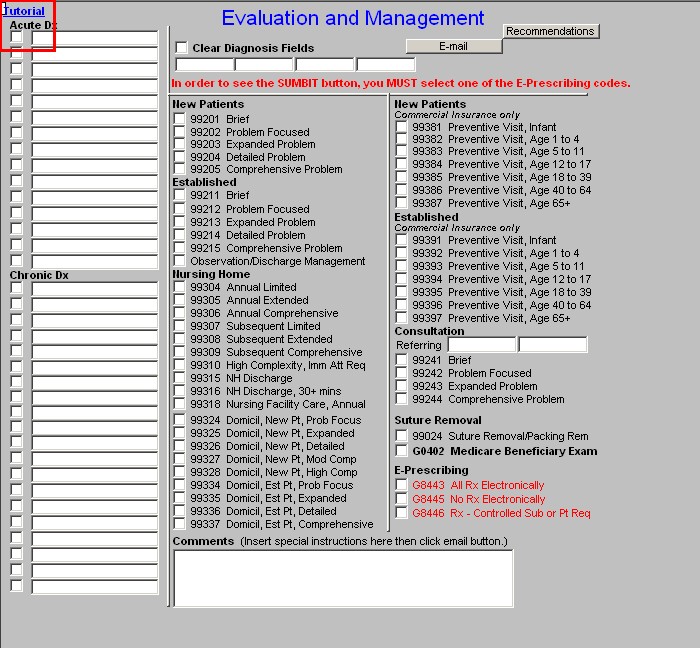
|
|
|
|
|
|
|
|
|
|
|